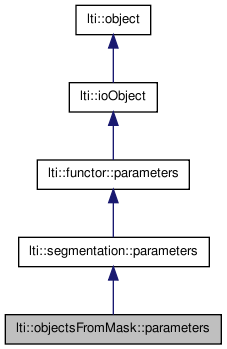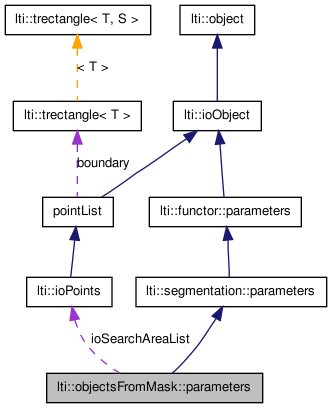

|
latest version v1.9 - last update 10 Apr 2010 |
|
the parameters for the class objectsFromMask More...
#include <ltiObjectsFromMask.h>


Public Member Functions | |
| parameters () | |
| parameters (const parameters &other) | |
| ~parameters () | |
| const char * | getTypeName () const |
| parameters & | copy (const parameters &other) |
| virtual functor::parameters * | clone () const |
| virtual bool | write (ioHandler &handler, const bool complete=true) const |
| virtual bool | read (ioHandler &handler, const bool complete=true) |
Public Attributes | |
| int | threshold |
| bool | assumeLabeledMask |
| int | minSize |
| int | level |
| bool | meltHoles |
| bool | sortObjects |
| bool | sortByArea |
| lti::ioPoints | ioSearchAreaList |
the parameters for the class objectsFromMask
| lti::objectsFromMask::parameters::parameters | ( | ) |
default constructor
Reimplemented from lti::segmentation::parameters.
| lti::objectsFromMask::parameters::parameters | ( | const parameters & | other | ) |
copy constructor
| other | the parameters object to be copied |
Reimplemented from lti::segmentation::parameters.
| lti::objectsFromMask::parameters::~parameters | ( | ) | [virtual] |
destructor
Reimplemented from lti::segmentation::parameters.
| virtual functor::parameters* lti::objectsFromMask::parameters::clone | ( | ) | const [virtual] |
returns a pointer to a clone of the parameters
Reimplemented from lti::segmentation::parameters.
| parameters& lti::objectsFromMask::parameters::copy | ( | const parameters & | other | ) |
copy the contents of a parameters object
| other | the parameters object to be copied |
Reimplemented from lti::segmentation::parameters.
| const char* lti::objectsFromMask::parameters::getTypeName | ( | ) | const [virtual] |
returns name of this type
Reimplemented from lti::segmentation::parameters.
| virtual bool lti::objectsFromMask::parameters::read | ( | ioHandler & | handler, | |
| const bool | complete = true | |||
| ) | [virtual] |
write the parameters in the given ioHandler
| handler | the ioHandler to be used | |
| complete | if true (the default) the enclosing begin/end will be also written, otherwise only the data block will be written. |
Reimplemented from lti::segmentation::parameters.
| virtual bool lti::objectsFromMask::parameters::write | ( | ioHandler & | handler, | |
| const bool | complete = true | |||
| ) | const [virtual] |
write the parameters in the given ioHandler
| handler | the ioHandler to be used | |
| complete | if true (the default) the enclosing begin/end will be also written, otherwise only the data block will be written. |
Reimplemented from lti::segmentation::parameters.
Regards input channel/matrix as a "labeled" mask if true.
Connected regions with identical label numbers are extracted. Note: labels below threshold are regarded as background!
Default is false
Generally the whole input channel8 / imatrix is as top-level for detection.
Instead you may specify any region for search with this parameter. Default is an empty list, which means the whole channel8 / imatrix will be used.
This value defines the maximum recursion depth for object and hole extraction.
The level number corresponds to the maximum depth of the tree.
I.e. level=0: search top-level for objects
level=1: find holes in top-level objects
level=2: search objects within holes of top-level objects
level=3: find their holes ...
Default is -1, which means the recursion goes as deep as possible
It is possible to close the holes within an object by setting this value.
This isn't necessary, if for example level==0, since holes inside objects aren't considered then anyway.
Default is false
This value defines the minimum size that an object must have in order to be detected.
Please note that this refers to the size of the data structure, not the actual object! I.e. if borderPoints are extracted, minSize refers to the minimum number of border points (which, by the way, is not the border length! see eBoundaryDefinition). So, a rough correspondence to the object's area is only given if areaPoints are extracted. In other words, the meaning of this parameter depends on which of the apply methods is used.
Default is 1
Use objects' actual area size for sorting (true), or rather the size of the data structure itself (false; default).
This parameter lets the objects be sorted by the size of the pointList type used.
This option will be ignored for the tree-apply().
Sorting by "size" means sorting considering the size of the pointList used in each specific apply() method. I.e. for areaPoints this will be the number of area pixels, for border points, the number of pixels at the border, and for ioPoints the number of input-output points.
Default is false
A value >= this threshold is regarded as object (*), all other values are background (-).
Default is 1 (Only 0 (black) is background).
Possible range is (1..255)